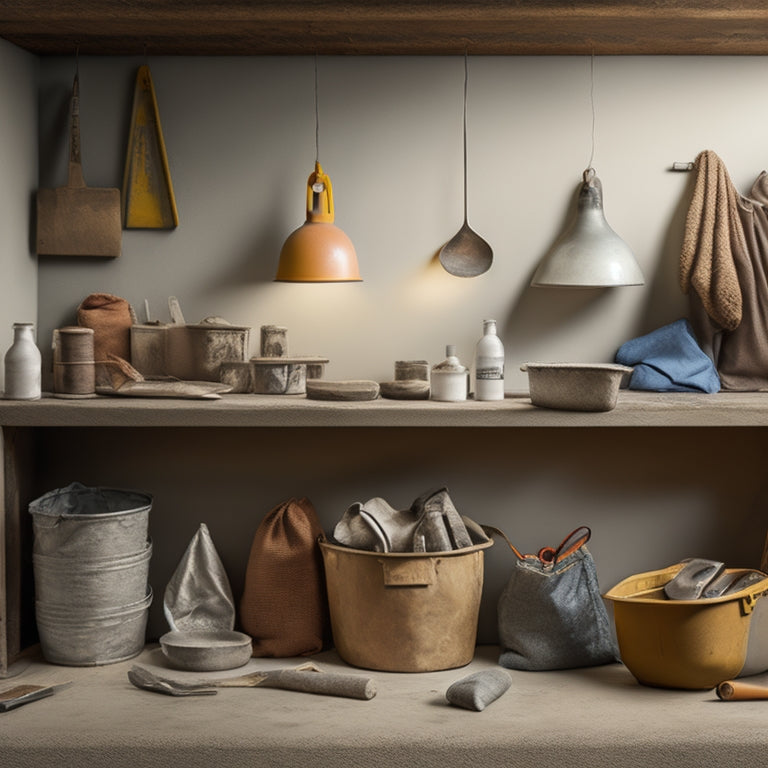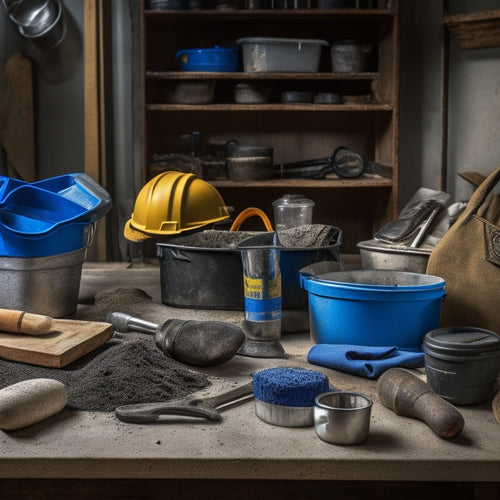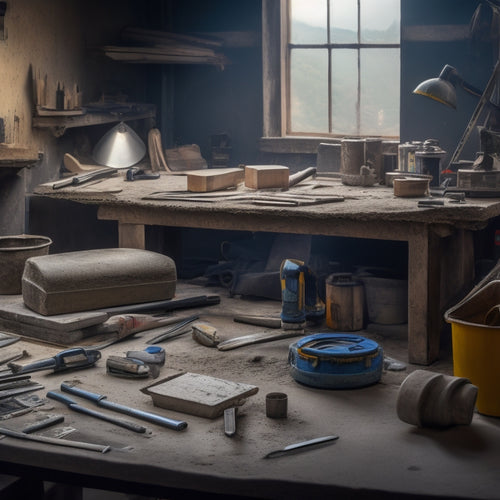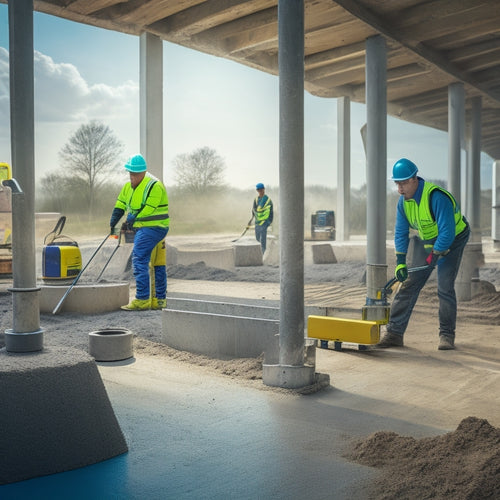
Top Picks for Concrete Wall Plastering Tools
Share
You'll need a solid toolkit to achieve a professional finish on your concrete wall plastering project. Start with essential smoothing tools like putty knives, wire brushes, and mixing buckets to prepare the surface. Next, invest in a quality trowel, plastering hawk, and heavy-duty mixer for efficient application. Don't forget edging and trimming tools, like putty knives and trimming trowels, to create clean lines and joints. Safety gear, like goggles and gloves, is also a must. With the right tools, you'll be well on your way to a smooth, professional finish - and there's more to explore to take your skills to the next level.
Key Takeaways
- Essential tools for smoothing, such as putty knives and wire brushes, are crucial for achieving a silky-smooth finish.
- Trowel blades, available in stainless steel, carbon steel, and various shapes, directly affect the final result of the concrete wall finish.
- A heavy-duty mixer is necessary for combining cement, sand, and water without lumps, ensuring a professional finish.
- Safety gear, including eye protection, dust masks, and gloves, is vital for protecting plasterers from hazardous materials and rough textures.
- Quality measuring and leveling tools, such as spirit levels and tape measures, prevent inaccuracies and ensure smooth finishes.
Essential Tools for Smoothing
As you prepare to smooth out your concrete wall, having the right tools at your disposal is essential. You can't just wing it with a hammer and some spare change (although, we've all been there). To master those sleek plastering techniques, you need the right gear.
First, you'll need a trusty putty knife for scraping off excess concrete and filling in gaps. Don't bother with a flimsy, flexible one - you want something sturdy that can withstand some elbow grease.
Next up, grab a wire brush for rough surface preparation. This bad boy will help you remove dirt, dust, and any remaining concrete chunks, ensuring a smooth canvas for your plastering masterpiece.
A mixing bucket and a measuring cup are also must-haves for mixing your plaster to the perfect consistency.
And let's not forget safety goggles and gloves to protect yourself from flying debris and harsh chemicals.
With these essential tools in your arsenal, you'll be well on your way to achieving a silky-smooth finish that'll make you the envy of the concrete jungle.
Trowels for Concrete Finishing
You'll need the right trowel blade for your concrete finishing project, as it directly affects the final result.
When selecting a trowel blade, consider the type of finish you're aiming for and the specific requirements of your project.
Trowel Blade Selection
Selecting the right trowel blade is essential for achieving a smooth, even finish on your concrete wall. You don't want to be stuck with a blade that's not up to the task, leaving you with a bumpy, uneven mess. So, what makes a great trowel blade?
First, consider the material. Stainless steel blades are durable and resistant to corrosion, making them perfect for wet concrete. Carbon steel blades, on the other hand, are more affordable and still get the job done.
Next, think about the shape. A rectangular blade is great for applying and smoothing large areas, while a pointed blade is perfect for getting into tight spaces and corners. You might also consider a curved blade for those tricky curved surfaces.
Lastly, think about the size. A larger blade will cover more ground, but may be harder to maneuver. A smaller blade will give you more precision, but may take longer to get the job done.
Finishing Edge Control
Now that you've chosen the right trowel blade, it's time to focus on finishing edge control. This is where the magic happens, and your concrete wall plastering skills shine. Finishing edge control is all about mastering the art of smoothing techniques and achieving impeccable edge aesthetics.
| Trowel Type | Edge Control | Smoothing Technique |
|---|---|---|
| Flex Trowel | Excellent for curved edges | Use gentle, sweeping motions |
| Rigid Trowel | Ideal for straight edges | Apply steady, consistent pressure |
| Combination Trowel | Versatile for various edges | Combine gentle and firm strokes |
| V-Trowel | Perfect for tight spaces | Use short, precise strokes |
| Edger Trowel | Designed for sharp, clean edges | Apply firm, controlled pressure |
Mixing and Applying Equipment
Most concrete wall plastering projects require a range of mixing and applying equipment to achieve a smooth, even finish.
You'll need the right tools to get the job done efficiently and effectively. When it comes to mixing, you'll want to master various mixing techniques to guarantee a consistent blend. A heavy-duty mixer or a mixing paddle attached to a drill is essential for combining cement, sand, and water. Don't forget to scrape the sides and bottom of the mixing bucket to avoid lumps.
For application, you'll need to choose the right tool for the job. A plastering trowel is a must-have for applying and smoothing out the plaster. You may also want to take into account a hawk or a mortar board to hold and carry the plaster.
Depending on the size of your project, you might need a spray gun or a rendering bucket for larger applications. Remember to experiment with different application methods, such as throwing, scratching, or floating, to achieve the desired texture and finish.
With the right mixing and applying equipment, you'll be well on your way to a professional-looking finish.
Edging and Trimming Tools
You'll need a range of edging and trimming tools to tidy up the edges, corners, and joints of your concrete wall plastering project.
Don't worry, we've you taken care of! Edging techniques require precision, and the right tools can make all the difference. You'll need a putty knife or edging trowel to create a clean, sharp edge where the plaster meets the surrounding surface.
For tighter spaces, a trim tool or joint knife comes in handy. Trimming methods vary, but having the right tools guarantees a professional finish. A trimming trowel or edger helps you achieve a smooth, even joint.
Don't forget about corner trim tools, which help create crisp, 90-degree angles. With these tools, you'll be able to master edging and trimming like a pro.
Finishing and Texturing Options
With your edges and joints neatly trimmed, it's time to focus on the final aesthetic of your concrete wall plastering project.
Now, you get to add some personality to your walls! Finishing and texturing options are where you can really get creative. You've got a blank canvas, and it's up to you to decide how much flair you want to add.
Textured finishes are a great way to add some visual interest to your walls. From subtle knockdowns to more dramatic orange peel effects, the right texture can elevate your project from bland to grand.
And if you're feeling extra fancy, decorative techniques like stamping or stenciling can take your walls to the next level. Just remember to choose a finish that complements your overall design, and don't be afraid to experiment with different tools and techniques to achieve the look you want.
With a little practice and patience, you'll be a master of textured finishes in no time!
Safety Gear for Plasterers
You can't afford to skimp on safety gear when working with concrete wall plastering tools.
You'll need to prioritize eye protection essentials, such as goggles or safety glasses, to prevent debris and dust from causing serious eye damage.
Additionally, you'll want to take into account dust mask necessities and glove selection matters to safeguard your respiratory system and hands from harsh materials and rough textures.
Eye Protection Essentials
Most plasterers can attest that a single speck of debris in the eye can bring an entire project to a grinding halt. You don't want to be that guy who's stuck with a throbbing eye, trying to explain to the foreman why the job's not getting done on time.
That's why eye protection essentials are non-negotiable when it comes to concrete wall plastering.
You've got options when it comes to protecting your peepers. Goggles are a great choice, and there are several types to choose from. Clear lenses are perfect for indoor work, while tinted lenses are better suited for outdoor projects.
If you're working with particularly hazardous materials, consider stepping up to a face shield. These provide extra protection for your entire face, not just your eyes.
Whichever you choose, make sure it's ANSI-approved and fits comfortably. You don't want to be fiddling with your gear when you should be focusing on the task at hand. Trust us, your eyes (and your project timeline) will thank you.
Dust Mask Necessities
Protecting your eyes from debris is just the beginning; concrete wall plastering also involves dealing with airborne dust and particles that can wreak havoc on your respiratory system. You need a reliable dust mask to keep you breathing easy.
There are several dust mask types to choose from, including disposable paper masks, half-face respirators, and full-face respirators. Disposable paper masks are great for low-dust tasks, while half-face respirators offer better protection for more intense projects. Full-face respirators provide the highest level of protection, but can be bulkier and hotter to wear.
Regardless of the type you choose, mask maintenance is essential. Regularly inspect your mask for signs of wear and tear, and replace it when necessary. Make sure to follow the manufacturer's instructions for cleaning and storing your mask.
A well-maintained dust mask can be the difference between a healthy workday and a trip to the doctor's office. Don't take any chances – invest in a good dust mask and take care of it, so it can take care of you.
Glove Selection Matters
Concrete wall plastering demands a firm grip on your tools and materials, and that's where the right pair of gloves comes in. You don't want to be fumbling around with a heavy trowel or bag of cement, only to have it slip out of your hands and create a mess. That's why choosing the right gloves is essential.
When it comes to glove materials, you've got options. Here's a breakdown:
| Material | Benefits |
|---|---|
| Cotton | Breathable, comfortable, and affordable |
| Synthetic | Durable, water-resistant, and easy to clean |
| Hybrid | Combines cotton's comfort with synthetic's durability |
Comfort fit is also key. You want gloves that fit snugly but not too tightly, allowing for dexterity and flexibility. Look for gloves with grip patterns on the palm to help with traction, and reinforced fingers for added protection. Remember, the right gloves can make all the difference in your plastering game. So, take the time to choose wisely – your hands (and your project) will thank you!
Measuring and Leveling Essentials
Get ready to tackle the foundation of your plastering project by gathering the essential measuring and leveling tools. You can't achieve a smooth, even finish without a solid understanding of measurement techniques and leveling accuracy.
Invest in a reliable spirit level, like a bubble level or a laser level, to guarantee your walls are plumb and your surfaces are even. A good level will help you identify any deviations from the norm, saving you from costly rework down the line.
Next, grab a sturdy tape measure that can withstand the rough and tumble world of construction. Look for one with clear, easy-to-read markings and a durable casing that can withstand drops and bumps.
Don't skimp on the quality – a cheap tape measure can lead to inaccurate readings and a wonky final product.
Frequently Asked Questions
How Do I Prevent Concrete From Sticking to My Plastering Tools?
You're stuck on how to prevent concrete from sticking to your plastering tools? First, choose the right tool selection with non-stick coatings or apply a release agent. Then, prep surfaces properly, and voilà! Your tools will be concrete-free and ready for the next job!
Can I Use a Power Trowel for Small Concrete Repair Projects?
You're wondering if a power trowel is worth it for small concrete repair projects? Absolutely, it's a game-changer! It'll boost your efficiency, saving you time and energy, and its benefits far outweigh the investment for any small project.
What Is the Ideal Temperature for Applying Concrete Plaster?
Ah, the perfect plaster job - it's all about the temp, my friend! You're aiming for ideal weather, between 50°F to 70°F (10°C to 21°C), when the mix is just right, and temperature effects won't ruin your smooth finish.
How Do I Clean and Maintain My Concrete Plastering Equipment?
You're done plastering, now don't neglect your gear! Clean your tools with soap and water, dry thoroughly, and store them properly. Regular equipment inspection will save you time and headaches - trust us, you won't regret it!
Are There Any Eco-Friendly Alternatives to Traditional Concrete Plaster?
You're looking for eco-friendly alternatives to traditional concrete plaster? You're on the right track! Explore sustainable materials like recycled aggregate, and green additives like cornstarch or bamboo fibers to reduce your carbon footprint.
Conclusion
As you wrap up your concrete wall plastering project, it's likely you'll look back and realize that having the right tools made all the difference. Coincidence? We think not! The trowels that smoothed out imperfections, the mixing equipment that got the consistency just right, and the safety gear that protected you from harm all came together to produce a finish that's nothing short of amazing. Now, go ahead and take pride in your handiwork - you've earned it!
Related Posts
-

5 Tools Needed for Quick Fix Concrete Mixing
You'll need five essential tools to tackle a quick fix concrete mixing project efficiently. First, you'll require a s...
-

3 Best Hand Tools for DIY Concrete Construction
When tackling a DIY concrete construction project, you'll need three essential hand tools to achieve a professional-l...
-

What Tools Ensure Precise Concrete Leveling Results
You need a range of specialized tools to achieve precise concrete leveling results. Laser leveling instruments provid...


